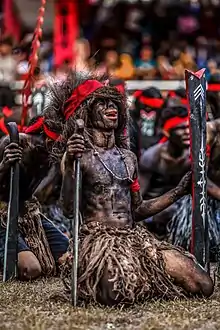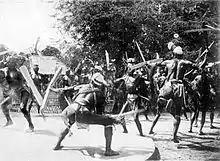 Cakalele dance performance | |
| Native name | Tari cakalele |
|---|---|
| Inventor | Eastern Indonesia |
| Origin | Indonesia |
| Cakalele dance |
|---|
|
| Burma |
| Cambodia |
| Indonesia |
|
| Laos |
| Malaysia |
| Philippines |
| Thailand |
|
| Vietnam |
Cakalele dance (pronounced "cha-ka-leh-leh", spelled tjakalele by the Dutch) is a war dance from North and Central Maluku in Indonesia.[1] Hybrid versions also exist among the natives of Sulawesi, Timor, and the Tanimbar Islands. The dance is performed by men, two of whom represent opposing captains or leaders while the others are the warriors supporting them. After an opening ritual, the captains engage in a mock-duel with a spear (sanokat) and long knife (lopu) while their supporters use a long knife in the right hand and a narrow wooden shield in the left hand.[2] The shield is referred to as a salawaku, or by a local name such as the Tobelo o dadatoko.[3] The cakalele originated as a way for the warriors to celebrate after a successful raid. Dancers dress in full warrior costume and are backed by the rhythm of the drum and gong (tifa) and fife (sulin).
Gallery
 Cakalele dancers wearing traditional clothes
Cakalele dancers wearing traditional clothes Cakalele dance performances in Maluku
Cakalele dance performances in Maluku Salawaku, the shield used in performances
Salawaku, the shield used in performances Cakalele dance performances in the 1900s
Cakalele dance performances in the 1900s Two cakalele dancers
Two cakalele dancers Cakalele performance
Cakalele performance
See also
Notes
- ↑ Qurtuby, Sumanto Al (2016-05-20). Religious Violence and Conciliation in Indonesia: Christians and Muslims in the Moluccas. Routledge. ISBN 9781317333289.
- ↑ Albert G Van Zonneveld (2002). Traditional Weapons of the Indonesian Archipelago. Koninklyk Instituut Voor Taal Land. ISBN 90-5450-004-2.
- ↑ P. E. De Josselin De Jong (1984). Unity in Diversity: Indonesia as a Field of Anthropological Study. Foris Publications. ISBN 90-6765-063-3.
External links
.svg.png.webp)





